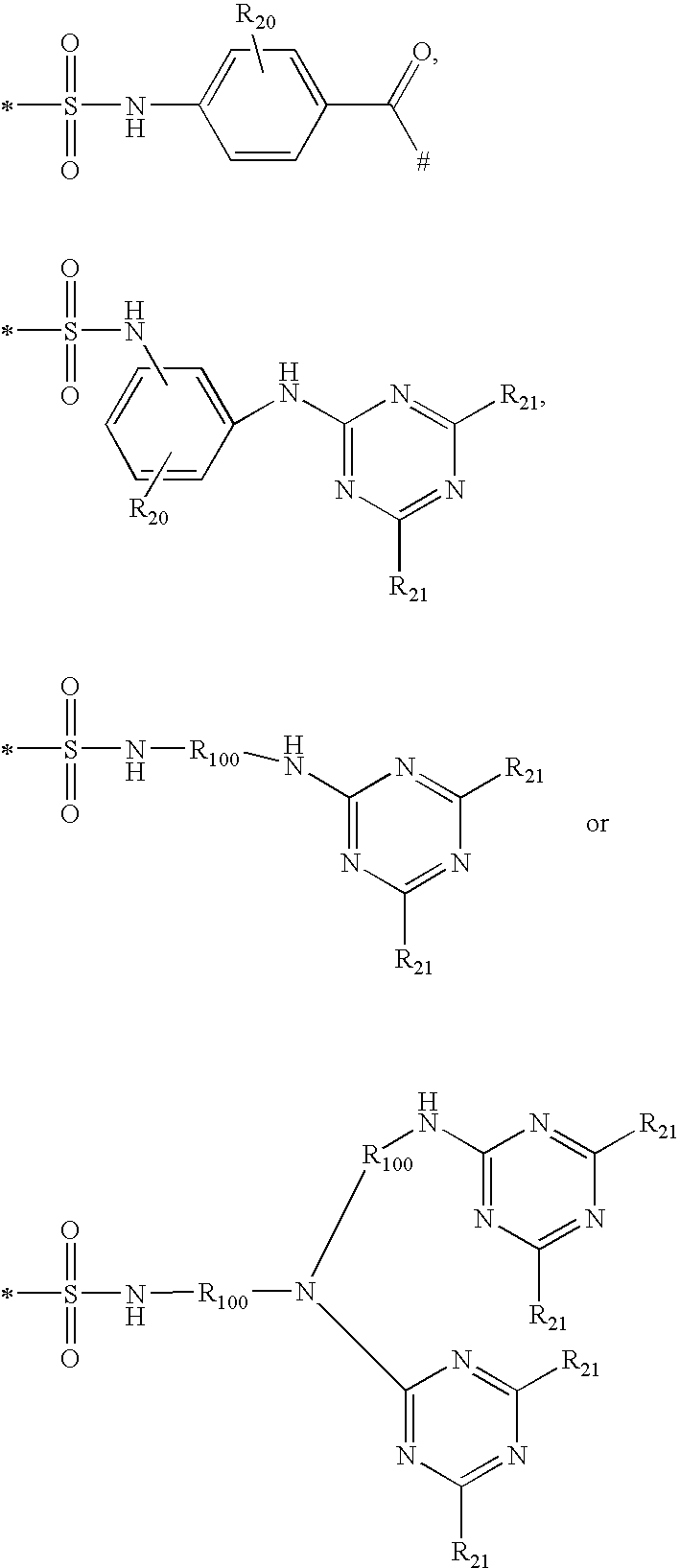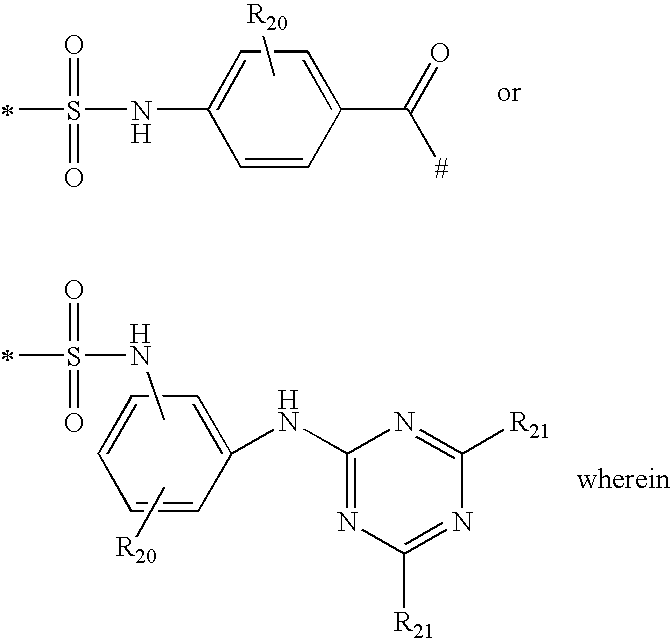Shading compositions
a composition and composition technology, applied in the field of shading compositions, can solve the problems of significant accumulation and insufficient photodegradation of dye conjugates
- Summary
- Abstract
- Description
- Claims
- Application Information
AI Technical Summary
Benefits of technology
Problems solved by technology
Method used
Image
Examples
example a1
Synthesis of a Zinc Phthalocyanine Monoazo Dye Conjugate
a) Synthesis of a Zinc Phthalocyanine sulfonyl Chloride Derivative
[0373]
2.0 g Zinc phthalocyanine tetrasulfonic acid sodium salt, 15 ml chlorosulfuric acid and 2.6 ml of thionyl chloride are reacted as given in the general procedure 1b). The reaction mixture is given onto 50 g ice. The precipitate is isolated as described above and directly used for further reactions.
b) Preparation of the Monoazo Dye:[0374]I) Preparation of the coupling component: 0.05 mol of N-(4-aminobenzoyl)-H-acid are suspended in 100 ml water and adjusted to pH 7.5 with aqueous solution of 30% sodium hydroxide.[0375]II) Suspension and diazotization of 1-aminonaphthalene: 7.14 g (0.05 mol) 1-aminonaphthalene is suspended in a mixture of 100 ml water and 5 ml hydrochloric acid (32%). The temperature of this suspension is increased to 30° C. until a solution is formed. Again 12 ml of hydrochloric acid (32%) is added. Afterwards the solution is cooled down to ...
example a2
Synthesis of a Zinc Phthalocyanine Monoazo Triazine Dye Conjugate
[0383]
a) Preparation of the Monoazo Triazine Dye[0384]I) Synthesis of the monoazo intermediate. The monoazo 1-naphthylamine-diazo to H-acid is prepared by diazotization of commercially available 1-aminonaphthalene, coupling to acetylated H-acid and finally, alkaline hydrolysis.
[0385]Acetylation of H-acid: 191.9 g (0.5 mol) H-acid (83%) is suspended in 500 ml water and dissolved at pH 7 by the addition of 48.6 ml aqueous NaOH (30%). 92.1 g acetic acid anhydride is slowly added over the course of 10 minutes. The reaction solution is cooled to 10° C. by the addition of 250 g ice; with 118.3 ml aqueous NaOH (30%) a pH of 7 is adjusted. Further 56.2 ml aqueous NaOH (30%) is added. A pH value of 10.5 is maintained for 1 hour at a temperature of 30° C. by the addition of 4.8 ml NaOH (30%). By addition of 32.9 ml aqueous HCl (32%), the solution is adjusted to a pH value of 7.2. The solution is cooled to 20° C. with 180 g ice. ...
example a3
Synthesis of a Zinc Phthalocyanine bis(monoazo) Triazine Dye Conjugate
[0394]
a) Preparation of the bis(monoazo)-triazine Dye
[0395]This dye can be prepared following two different synthetic procedures:[0396]1) The Monoazo, 1-Naphthylamine-diazo to H-acid, is synthesized according to the procedure given in example A2. Afterwards 2 mole-equivalents of the monoazo are condensed to 1 mole-equivalent of cyanuric chloride, the last condensation is done with 1 mole-equivalent of m-phenylenediamine.[0397]I) An aqueous solution of 0.060 mol 5-amino-4-hydroxy-3(naphthalen-1-ylazo)-naphthalene-2,7-disulfonic acid was stirred at room temperature. A suspension consisting of 100 ml of ice water, 0.1 g disodium hydrogen tetraoxophosphate and 5.53 g (0.03 mol) cyanuric chloride is added to the intermediate. The reaction mixture is adjusted and kept with aqueous sodium hydroxide solution (30%) at pH 7. After 30 minutes the reaction mixture is heated to 70° C. and pH 7 is kept for several hours until t...
PUM
| Property | Measurement | Unit |
|---|---|---|
| pH | aaaaa | aaaaa |
| relative hue angle | aaaaa | aaaaa |
| temperature | aaaaa | aaaaa |
Abstract
Description
Claims
Application Information
 Login to View More
Login to View More - R&D
- Intellectual Property
- Life Sciences
- Materials
- Tech Scout
- Unparalleled Data Quality
- Higher Quality Content
- 60% Fewer Hallucinations
Browse by: Latest US Patents, China's latest patents, Technical Efficacy Thesaurus, Application Domain, Technology Topic, Popular Technical Reports.
© 2025 PatSnap. All rights reserved.Legal|Privacy policy|Modern Slavery Act Transparency Statement|Sitemap|About US| Contact US: help@patsnap.com



